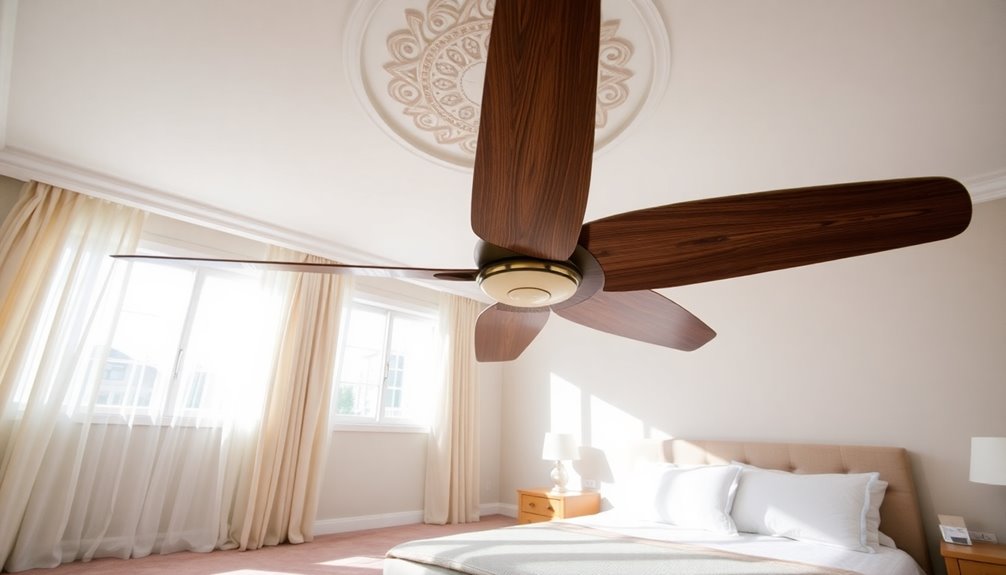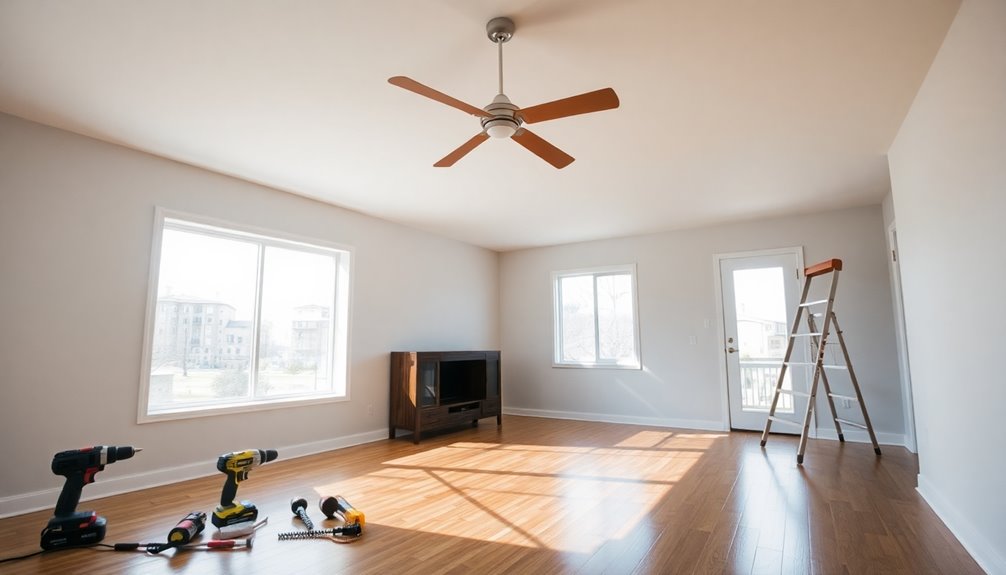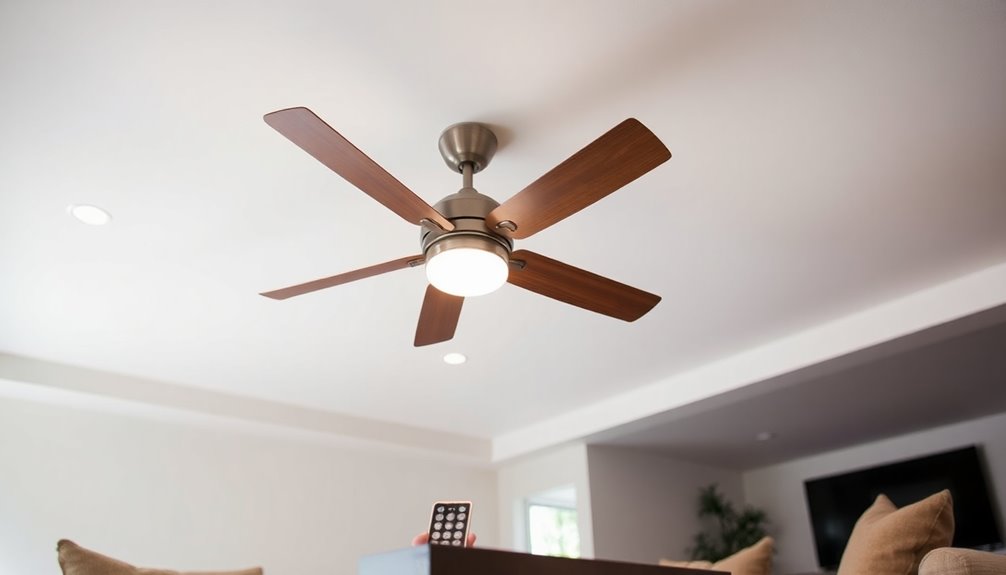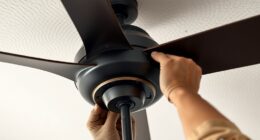To choose the right size ceiling fan, measure your room first. For rooms up to 100 sq ft, opt for fans between 29-36 inches. If your space is between 75 to 144 sq ft, select a fan that's 36-42 inches. For areas of 144 to 225 sq ft, aim for a 44-50 inch fan. Larger spaces over 225 sq ft will need fans measuring 52 inches or more. Remember that airflow matters too, so check the fan's CFM rating for ideal comfort. Keep going to uncover more tips on ensuring you pick the perfect ceiling fan for your home!
Key Takeaways
- Measure your room dimensions to determine square footage for appropriate fan sizing: 29-36 inches for up to 100 sq ft, 52 inches or larger for over 225 sq ft.
- Choose a fan with a CFM rating suitable for your room size; 1,000-2,000 CFM for small rooms, 8,000+ CFM for larger spaces.
- Ensure the fan blades are positioned about 8 feet from the floor for optimal airflow and safety, with a minimum clearance of 7 feet.
- Consider room conditions such as heat sources and sunlight exposure, which may require larger or more powerful fans for effective cooling.
- Select a fan design that complements your room decor while ensuring it meets airflow and energy efficiency requirements for long-term savings.
Importance of Ceiling Fan Size

When it comes to comfort in your home, the size of your ceiling fan plays a key role. Selecting the right ceiling fan sizes is vital for achieving ideal airflow and energy efficiency. If you choose a fan that's too small, you won't get the cooling effect you need, while an oversized fan can create uncomfortable drafts.
For small rooms up to 100 square feet, fans should be between 29-36 inches in diameter. Larger spaces, up to 400 square feet, generally require fans sized between 36-50 inches. Great rooms over 400 square feet benefit from fans that span 50-71 inches to guarantee adequate air circulation.
Moreover, pay attention to the fan's CFM rating, which indicates its air movement capacity. Higher CFM ratings result in better airflow, enhancing your comfort level.
Misjudging fan size can lead to increased energy costs and reduced comfort, making it necessary to choose wisely. By understanding the importance of ceiling fan size, you can create a more pleasant living environment and maximize energy savings.
Measuring Room Dimensions

Measuring room dimensions accurately is fundamental for selecting the right ceiling fan size. Start by using a tape measure to find the length and width of your room. Multiply these two measurements to calculate the square footage. For instance, if your room measures 12 feet by 15 feet, you'll have a total area of 180 square feet, which is essential for determining the appropriate ceiling fan size.
If your room is irregularly shaped, divide it into smaller rectangles, measure each section, and sum their areas to get the total square footage. Accurate measurements guarantee you choose the right ceiling fan size, which is critical for ideal airflow and energy efficiency.
Here's a quick reference table to help you understand the relationship between room size and ceiling fan size:
| Room Size (sq ft) | Recommended Fan Size | Fan Diameter |
|---|---|---|
| Up to 144 | 42 inches | 42 inches |
| 145 – 400 | 52 inches | 52 inches |
| 401 – 625 | 56 inches | 56 inches |
| 626+ | Custom | Varies |
Recommended Fan Sizes

When you're selecting a ceiling fan, it's crucial to take into account your room size.
For ideal airflow, each room size has a recommended fan diameter that guarantees effective cooling.
Let's break down the sizes so you can find the perfect fan for your space.
Room Size Considerations
Choosing the right ceiling fan size for your room is essential for effective air circulation. You want to guarantee that your fan provides ideal airflow based on your room size considerations. Here's a quick guide to help you choose the appropriate ceiling fan size:
| Room Size | Recommended Fan Size |
|---|---|
| Up to 100 sq ft | 29 to 36 inches |
| 75 to 144 sq ft | 36 to 42 inches |
| 144 to 225 sq ft | 44 to 50 inches |
| Over 225 sq ft | 52 inches or larger |
For small rooms up to 100 square feet, a fan size of 29 to 36 inches works best. Medium rooms measuring 75 to 144 square feet typically require fans that are 36 to 42 inches in diameter. If your space is large, ranging from 144 to 225 square feet, look for fans sized 44 to 50 inches. Finally, for extra-large areas exceeding 225 square feet, opt for fans with a diameter of 52 inches or more. By following these guidelines, you can enhance comfort and achieve ideal airflow throughout your home.
Fan Diameter Recommendations
To guarantee ideal airflow in your space, selecting the appropriate fan diameter is key. The right fan size greatly enhances air circulation and keeps your room comfortable.
For small rooms up to 100 square feet, opt for a ceiling fan that measures between 29 to 36 inches in diameter. This size guarantees ideal airflow without overwhelming the space.
If your room is medium-sized, ranging from 100 to 175 square feet, you should choose a fan with a diameter of 36 to 42 inches. This range strikes a balance between efficiency and comfort.
For larger rooms, which span 175 to 350 square feet, aim for a fan size of 44 to 50 inches to achieve adequate air circulation.
Lastly, if you're dealing with extra-large spaces that exceed 350 square feet, a ceiling fan with a diameter of 52 inches or larger is required.
It's crucial to match the fan size to your room size for effective airflow, assuring you maintain comfort and energy efficiency.
Airflow Capacity Ratings
Understanding airflow capacity ratings is essential for selecting the right ceiling fan size for your space. The CFM (cubic feet per minute) ratings directly influence air circulation, making sure your room stays comfortable. Here's a quick reference table to help you choose the right fan size based on your room's square footage and desired airflow:
| Room Size (sq ft) | Recommended Fan Size (inches) | CFM Ratings |
|---|---|---|
| Up to 100 | 29-36 | 1,000 – 2,000 |
| 144 – 225 | 42-44 | 2,000 – 4,000 |
| Over 400 | 50-71 | 8,000 or more |
For smaller rooms (50-75 sq ft), fans with CFM ratings of 1,000-2,000 are suitable. However, larger spaces (over 225 sq ft) require fans nearing 8,000 CFM for peak air circulation. Remember, choosing the right ceiling fan size not only enhances cooling efficiency but also reduces energy costs. Make sure your fan has at least 18 inches of clearance from walls to maximize airflow.
Understanding CFM Ratings

Understanding CFM ratings is vital for choosing the right ceiling fan for your space.
A higher CFM means better air circulation, which directly impacts your comfort level.
For best performance, it's important to match the CFM rating with the size of your room.
CFM Measurement Importance
Choosing the right ceiling fan involves recognizing the significance of CFM ratings, as they directly impact your comfort level. CFM, or cubic feet per minute, measures a ceiling fan's airflow capacity, indicating how much air the fan can move in a minute. Higher CFM ratings generally lead to better air circulation, especially in larger rooms. Understanding the relationship between room size and CFM is vital for effective cooling and heating.
Here's a quick overview of recommended CFM ratings based on room sizes:
| Room Size | Recommended CFM Range | Suitable Fan Type |
|---|---|---|
| Tiny Rooms (≤50 sq ft) | Below 1,000 | Small, low-profile fans |
| Small Rooms (up to 75 sq ft) | 1,000 – 2,000 | Medium-sized fans |
| Medium Rooms (up to 350 sq ft) | 2,000 – 6,000 | Standard fans |
| Large Rooms (over 350 sq ft) | Over 8,000 | High-capacity or multiple fans |
For energy-efficient fans, you'll find that they often have higher CFM ratings, helping reduce energy costs while maintaining comfort in your home.
Optimal CFM Recommendations
When it comes to ideal CFM recommendations, selecting the right airflow capacity for your ceiling fan is essential for maintaining comfort in your space. CFM, or cubic feet per minute, measures how much air your fan can move.
For small rooms, typically 50-75 sq ft, aim for a CFM rating between 1,000 and 2,000. This range provides adequate airflow for comfort. In standard rooms, which are 75-175 sq ft, look for fans with a CFM rating up to 3,800 for effective air circulation.
If you have a large room, around 175-350 sq ft, your fan should have a CFM rating up to 8,000. Great rooms, exceeding 350 sq ft, benefit from fans with CFM ratings over 8,000 to guarantee sufficient airflow.
Always consider your room size when selecting a ceiling fan; the right CFM rating won't only enhance comfort but also promote energy savings. By matching your fan's CFM with your room's dimensions, you'll create a more enjoyable environment, avoiding stuffiness or excessive cooling.
Choose wisely, and your ceiling fan will make a significant difference in your space.
Ceiling Fan Height Considerations

Properly positioning your ceiling fan is essential for maximizing airflow and guaranteeing safety. The ideal height for your fan blades is approximately 8 feet from the floor, allowing for peak airflow and comfort.
If your ceiling height is under 8 feet, consider using a low-profile or flush mount fan to maintain adequate clearance and airflow. Make sure your fan is installed at least 7 feet above the floor to prevent safety hazards. Regular maintenance can help ensure that your fan operates efficiently. Additionally, selecting a fan with a high CFM rating can further enhance airflow in smaller spaces.
For standard mount fans, aim for a minimum of 12-14 inches of clearance between the ceiling and the fan blades. This distance enhances airflow efficiency and guarantees the fan operates effectively.
If you have a higher ceiling, you'll need to use downrods to achieve the peak height. To determine the appropriate downrod length, measure your ceiling height and subtract 12 inches for light kits. This will help you achieve a comfortable viewing experience while maximizing airflow. Additionally, using a downrod installation can enhance fan performance by increasing airflow and improving overall efficiency.
Mounting Options Explained

When choosing the right mounting option for your ceiling fan, it's essential to take into account your ceiling height.
Flush mount fans offer a sleek look and are perfect for low ceilings, while downrod mounts provide better airflow for higher spaces.
Each option has its benefits, so understanding these can help you make the best choice for your home.
Flush Mount Advantages
Flush mount ceiling fans offer a practical solution for spaces with low ceilings, allowing you to enjoy both style and functionality without sacrificing headroom. Typically mounted directly to the ceiling, these fans create a sleek and streamlined look while maintaining a minimum clearance of 7 feet above the floor. This design guarantees safety and comfort in areas where vertical space is limited.
One of the primary advantages of choosing a flush mount fan is its effectiveness in air circulation. In smaller rooms, where a traditional downrod mount fan could obstruct movement, a flush mount provides ideal airflow without getting in the way. The blades sit just 6 to 10 inches from the ceiling, promoting efficient air circulation throughout the room.
Additionally, flush mount fans often come in various styles and finishes, making them an aesthetically pleasing option that complements your décor. Whether you're outfitting a bedroom, living room, or any small space, opting for a flush mount fan maximizes headroom while guaranteeing a comfortable atmosphere.
With these features, you can achieve both comfort and style in your low ceiling areas.
Downrod Mount Benefits
Downrod-mounted ceiling fans are a fantastic choice for high ceilings, allowing you to enhance airflow and comfort in larger spaces. By using a downrod, you can lower the fan to about 8 feet from the floor, ensuring the blades have sufficient clearance from the ceiling. This setup promotes better air circulation, which is essential for maintaining a comfortable environment.
Here's a quick overview of downrod options based on ceiling height:
| Ceiling Height | Recommended Downrod Length | Distance from Ceiling | Airflow Enhancement | Fan Stability |
|---|---|---|---|---|
| 8 feet | 0 inches | 12-14 inches | Moderate | Good |
| 10 feet | 12 inches | 12-14 inches | Excellent | Very Good |
| 12 feet | 24 inches | 12-14 inches | Ideal | Excellent |
| 14 feet | 36 inches | 12-14 inches | Superior | Exceptional |
| 16 feet | 48 inches | 12-14 inches | Maximum | Stable |
Proper installation of downrod mounts enhances fan performance and minimizes overheating risks, making them ideal for high-ceiling spaces.
Blade Design and Efficiency

Choosing the right blade design for your ceiling fan impacts both aesthetics and efficiency. While the appearance of the blades can enhance your room's décor, the blade pitch is essential for airflow efficiency. Fans with a higher blade pitch can move more air at lower speeds, which is important for keeping your space comfortable without hiking up your energy bills.
Typically, ceiling fans come with 4 to 5 blades, balancing style and airflow effectiveness. When considering airflow efficiency, pay attention to the CFM (cubic feet per minute) rating. A higher CFM means better airflow, which is critical for effective cooling and circulation.
Selecting a fan with energy-efficient blades can help reduce electricity costs while improving overall air movement in your room. Always check the blade design and pitch before making your purchase. Not only will this guarantee you get a fan that looks great, but it will also perform well for your specific needs.
Motor Types and Their Benefits

When it comes to selecting a ceiling fan, understanding the differences between motor types can greatly impact your comfort and energy costs. You'll primarily encounter AC and DC motors, each offering distinct benefits.
| Motor Type | Benefits |
|---|---|
| AC Motors | Cost-effective, typically three speed settings, easier installation |
| DC Motors | Faster startups, quieter operation, greater speed options, up to 70% more energy efficient |
AC motors are the most common, providing a budget-friendly option. However, they usually consume more energy and can be noisier. On the other hand, DC motors excel in energy efficiency, consuming considerably less power and reducing your energy bills over time. Though they come with a higher upfront cost, the long-term savings can be substantial.
When you choose a ceiling fan, consider how motor types influence not just your immediate costs but also your ongoing expenses. Opting for a fan with a DC motor can enhance your comfort while promoting a more sustainable lifestyle. By making an informed decision, you can enjoy a cooler environment without breaking the bank on energy costs.
Installation Tips for Ceiling Fans

Installing a ceiling fan can elevate your space and improve comfort, but it's imperative to do it correctly for best performance. To guarantee ideal airflow and safety, aim for a ceiling fan height of about 8 feet from the floor to the blades. If your ceiling is higher than 9 feet, you'll need to use a downrod to maintain that minimum clearance.
Here are a few tips to make your installation smoother:
- Choose a preassembled fan: This saves you time and simplifies the process.
- Check your electrical box: Make sure it's sturdy, preferably metal, and can support the fan's weight.
- Follow the manual: Adhering to the manufacturer's instructions is vital for safety and proper functionality.
- Measure carefully: Verify you have the right downrod length to keep the blades at the ideal height.
Additional Factors to Consider

Selecting the right ceiling fan involves more than just aesthetics; it's about ensuring comfort and efficiency in your living space. One essential factor to keep in mind is ceiling fan height. Install your fan at least 7 feet above the floor for safety and ideal airflow. This height helps prevent any obstruction and allows the fan to perform effectively.
Next, consider your room size and shape. Irregularly shaped rooms may need multiple fans to guarantee even air circulation. Larger spaces demand more powerful fans, so pay attention to the fan's CFM rating (cubic feet per minute). A higher CFM rating means better air movement, which is important for larger areas or outdoor spaces.
Additionally, think about the presence of heat-generating appliances or sunlight exposure. These factors can affect the fan's efficiency and might require you to opt for a larger or more powerful model to maintain comfort levels.
Finally, features like integrated lighting kits or remote controls can impact both the height and functionality of your ceiling fan, so consider these when making your choice.
Frequently Asked Questions
Is a 52 Inch Fan Too Big for a 12X12 Room?
Yes, a 52-inch fan is too big for a 12×12 room.
You'll find it can overpower the space and create uncomfortable airflow, almost like a wind tunnel effect.
For that size room, a fan between 36 to 50 inches works best, ensuring efficient air circulation and comfort.
How Do I Choose the Right Size Ceiling Fan?
Did you know that a ceiling fan can circulate air across a room up to 20 times per hour?
To choose the right size ceiling fan, start by measuring your room's square footage. For smaller rooms, opt for fans between 29-36 inches; for medium rooms, go for 36-50 inches.
Guarantee the fan is at least 8 feet above the floor to maximize airflow. Don't forget to take into account your ceiling height for ideal installation!
Is a 3 4 or 5 Blade Ceiling Fan Better?
When you're choosing between a 3, 4, or 5 blade ceiling fan, think about your room's needs.
A 3-blade fan moves air efficiently at higher speeds but can be noisier. In contrast, a 5-blade fan operates quietly but may not circulate air as effectively at lower speeds.
If aesthetics matter, a 4 or 5-blade fan offers balance, making it suitable for various spaces while reducing noise.
Ultimately, consider airflow and noise level for your comfort.
What Size Room for a 52 Inch Ceiling Fan?
A 52-inch ceiling fan's ideal for rooms up to 400 square feet.
It guarantees maximum airflow and cooling efficiency, making your space comfortable.
If your room's larger, you might need multiple fans to circulate air effectively.
Remember to measure your room dimensions to verify the fan fits well and doesn't overwhelm the aesthetics.
Keep at least 18 inches of clearance from walls for the best airflow and safety.
Enjoy your invigorating breeze!
Conclusion
Choosing the right ceiling fan size is like finding the perfect puzzle piece that completes your room. By measuring your space and understanding fan specifications, you can create a comfortable oasis in your home. Remember, it's not just about looks; efficiency and performance matter too. With the right fan, you'll enjoy a revitalizing breeze that dances through your space, making every moment at home a little cooler and a lot more enjoyable. Embrace the comfort!









